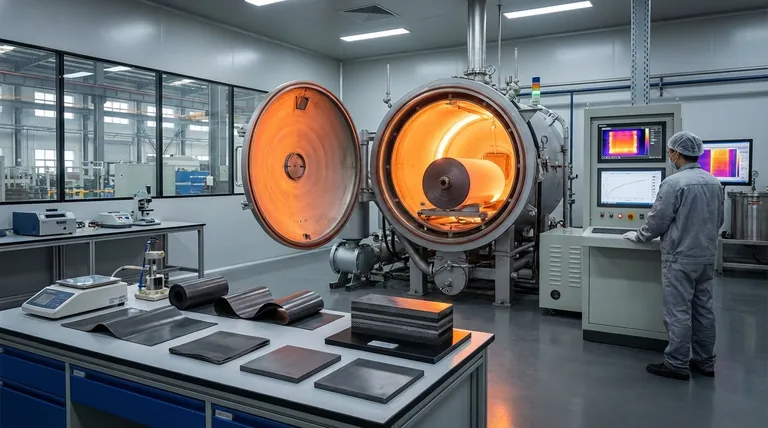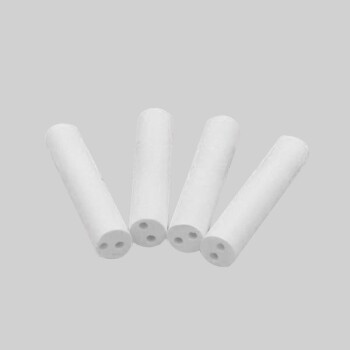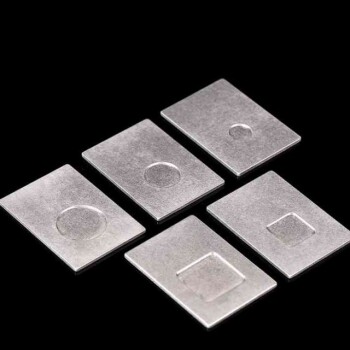The thermal conductivity of graphite is not a single number, but a range that depends profoundly on the material's structure and orientation. While a perfect crystal of stress-annealed pyrolytic graphite can exhibit an exceptionally high in-plane thermal conductivity of up to 4100 W/m·K, the values for commercially available forms are often much lower and vary significantly depending on their type and grade.
Graphite's value in thermal management comes from its profound anisotropy. Heat travels exceptionally well along its layered planes but poorly across them. Understanding this directional property and the different forms of graphite is the key to using it effectively.

Why Graphite's Conductivity Varies So Drastically
The massive variation in graphite's thermal conductivity stems from its unique atomic structure. It is composed of stacked layers of graphene sheets. The bonds within a sheet are incredibly strong, while the bonds between sheets are very weak.
The Concept of Anisotropy: In-Plane vs. Through-Plane
Heat, in the form of lattice vibrations (phonons), travels with extreme ease along the flat graphene planes. This is known as in-plane or "ab-plane" conductivity.
Conversely, it is very difficult for that heat energy to jump from one layer to the next. This is called through-plane or "c-axis" conductivity.
The result is a material that can have a thermal conductivity higher than copper in one direction and lower than ceramic in another. For pyrolytic graphite, this ratio can be several hundred to one.
The Role of Crystalline Structure
The theoretical maximum conductivity is only achievable in a near-perfect crystal structure with very few defects.
Defects, impurities, and grain boundaries act as scattering sites that impede the flow of phonons, effectively acting like roadblocks for heat.
Highly Oriented Pyrolytic Graphite (HOPG) or Annealed Pyrolytic Graphite (APG) has a large, well-aligned crystalline structure, which is why it exhibits the highest in-plane conductivity. Other forms, like synthetic graphite sheets, have smaller, less-perfectly aligned grains, which lowers the overall bulk conductivity.
A Spectrum of Graphite Forms
Different manufacturing processes yield different types of graphite, each with a characteristic thermal performance profile.
- Pyrolytic Graphite (PG/APG): The performance champion. It is grown through chemical vapor deposition to create a highly ordered, layered structure. Its conductivity is supreme in the ab-plane (typically 1500-2000 W/m·K) but poor in the c-axis (around 10-20 W/m·K).
- Natural & Synthetic Graphite Sheets: These are made by compressing and processing natural flake or synthetic graphite. They are flexible and more practical for many applications but have lower bulk conductivity (typically 400-1500 W/m·K) due to binders and a less-perfect crystal alignment.
- Isotropic Graphite: This is a specialized form engineered to have more uniform thermal properties in all directions. This is achieved by creating a random orientation of crystals, but it sacrifices the high peak conductivity of oriented graphite.
Understanding the Trade-offs
Choosing graphite is not just about finding the highest number. The ideal material for a lab experiment is rarely the right choice for a commercial product.
High Performance vs. Practicality
Annealed pyrolytic graphite offers unparalleled heat-spreading performance, but it is rigid, brittle, and expensive. It cannot be bent to conform to a surface, limiting its use to flat applications.
Flexibility vs. Absolute Conductivity
Flexible graphite sheets are incredibly useful for wrapping around components or fitting onto uneven surfaces. However, the binders and processing required to achieve this flexibility introduce thermal resistance and reduce the bulk conductivity compared to a solid block of PG.
Directionality as a Design Tool and a Trap
Graphite's anisotropy is a powerful design tool for heat spreading. It allows you to move heat laterally away from a hot spot very efficiently.
However, if your goal is to move heat through the thickness of the graphite sheet to a heat sink, it can be a significant bottleneck. A 0.5 mm thick sheet of pyrolytic graphite can have the same thermal resistance as a much thicker layer of aluminum in that direction.
Selecting the Right Graphite for Your Thermal Goal
Your choice must be driven by the specific engineering problem you are trying to solve.
- If your primary focus is maximum heat spreading away from a concentrated source: Annealed pyrolytic graphite (APG) is the best choice for this heat-spreader application, provided the interface is flat.
- If your primary focus is conforming to uneven surfaces for heat transfer: Flexible synthetic or natural graphite sheets are the practical solution.
- If your primary focus is moving heat efficiently through the material: Graphite is often a poor choice; consider copper or aluminum unless you are using specialized graphite foams or vertically-aligned structures.
- If your primary focus is a balance of cost, performance, and formability: Standard synthetic graphite sheets offer an excellent compromise for most consumer and industrial electronics.
By understanding these principles, you can select the precise form of graphite that functions as an engineered solution for your specific thermal challenge.
Summary Table:
| Graphite Type | Typical In-Plane Thermal Conductivity (W/m·K) | Typical Through-Plane Thermal Conductivity (W/m·K) | Key Characteristics |
|---|---|---|---|
| Pyrolytic Graphite (PG/APG) | 1500 - 2000 | 10 - 20 | Highest in-plane conductivity, rigid, expensive |
| Natural & Synthetic Graphite Sheets | 400 - 1500 | N/A (Bulk property) | Flexible, practical, lower bulk conductivity |
| Isotropic Graphite | Uniform in all directions | Uniform in all directions | Engineered for uniform thermal properties |
Struggling with a specific thermal management challenge in your lab? The right graphite material can be the key to an efficient solution. At KINTEK, we specialize in providing high-performance lab equipment and consumables, including a range of graphite products tailored for precise thermal applications. Whether you need a custom heat spreader or a conformable graphite sheet, our experts can help you select the ideal material for your experiment or process. Contact our thermal solutions team today to discuss your requirements and optimize your lab's performance with KINTEK's specialized graphite products.
Visual Guide

Related Products
- Graphite Vacuum Furnace High Thermal Conductivity Film Graphitization Furnace
- Vertical High Temperature Graphite Vacuum Graphitization Furnace
- Ultra-High Temperature Graphite Vacuum Graphitization Furnace
- Graphite Vacuum Continuous Graphitization Furnace
- Hexagonal Boron Nitride HBN Thermocouple Protection Tube
People Also Ask
- What are the applications of graphite material? Leveraging Extreme Heat and Precision for Industrial Processes
- What is the temperature of a graphite furnace? Achieve Extreme Heat Up to 3000°C
- Does graphite have a melting point? Unlocking the Extreme Heat Resistance of Graphite
- Can graphite withstand heat? Unlocking its extreme 3,600°C potential in inert environments
- What is the purpose of a graphite furnace? Achieve Extreme Temperatures for Advanced Materials











